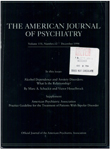Posttraumatic stress disorder in an urban population of young adults: risk factors for chronicity
Abstract
OBJECTIVE: Despite progress in epidemiologic research on posttraumatic stress disorder (PTSD), little is known about factors that distinguish chronic from nonchronic PTSD. In a previous report, the authors identified a set of personal predispositions associated with PTSD following traumatic events in a general population sample of young adults. The purpose of this analysis was to identify characteristics of chronic PTSD and examine whether any of the suspected risk factors for PTSD was associated specifically with chronic PTSD. METHOD: A random sample of 1,007 21- to 30-year-old members of a large health maintenance organization in the Detroit area was interviewed, using the National Institute of Mental Health Diagnostic Interview Schedule (DIS), revised for DSM-III-R. The analysis was performed on data from 394 respondents who reported traumatic events, of whom 93 met criteria for PTSD. Chronic PTSD was defined as duration of symptoms for 1 year or more. RESULTS: Persons with chronic PTSD (N = 53) had, on the average, a significantly higher total number of PTSD symptoms and higher rates of overreactivity to stimuli that symbolized the stressor and interpersonal numbing than persons with nonchronic PTSD. The rates of one or more additional anxiety or affective disorders and a variety of medical conditions were higher in persons with chronic than nonchronic PTSD. Family history of antisocial behavior and female sex were associated specifically with chronic PTSD. CONCLUSIONS: The findings suggest that chronic PTSD may be associated with specific risk factors and clinical features. Longitudinal data on the course of PTSD are needed to determine whether the distinct features and the medical and psychiatric histories of persons with chronic PTSD are complications attendant on a chronic course or coexisting disturbances that inhibit recovery.
Access content
To read the fulltext, please use one of the options below to sign in or purchase access.- Personal login
- Institutional Login
- Sign in via OpenAthens
- Register for access
-
Please login/register if you wish to pair your device and check access availability.
Not a subscriber?
PsychiatryOnline subscription options offer access to the DSM-5 library, books, journals, CME, and patient resources. This all-in-one virtual library provides psychiatrists and mental health professionals with key resources for diagnosis, treatment, research, and professional development.
Need more help? PsychiatryOnline Customer Service may be reached by emailing [email protected] or by calling 800-368-5777 (in the U.S.) or 703-907-7322 (outside the U.S.).



